Grimm by Heliotrope
Intro
Original SA post Grimm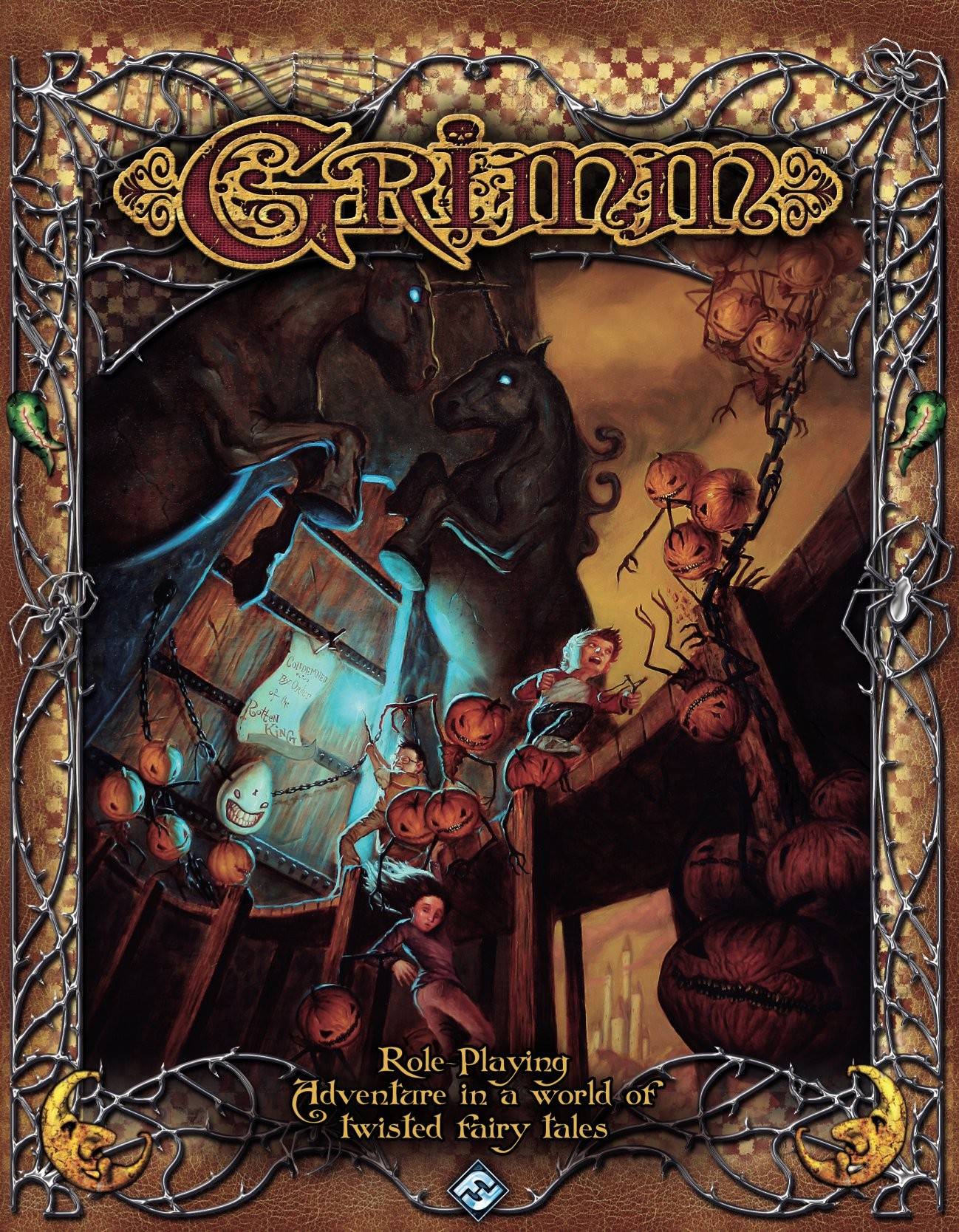
quote:
Grimm ... an aptly named excursion, both dream and nightmare, into the classic fairy tales of childhood. Despite the flights of fancy these fairy tales represent, something dark and brooding lies at their centers. Grimm takes those kernels of despair and pulls the players, kicking and screaming, into them. These stories are not the ones we remember. Something has happened, and the fairy tale worlds and their denizens have become dark, twisted, and dangerous.
Players take on the roles of kids trapped in these horrid places, with nothing but their wits and imagination to escape. Become the jock, the nerd, the popular kid, the bully, or the outcast. Deal with figures from Humpty Dumpty to Red Riding Hood’s wolf, and try to figure out which wants to have you over for dinner, and which wants to have you for dinner. Get ready to make your own stories...and don’t be surprised if the endings aren’t happy.
I've had this for a while now, and I really do like most of the ideas and setting of the game. Never had a chance to play it (so I'm not sure how the mechanics and all work out in play), but I thought it might be a fun thing to show for this thread.
Grimm was originally a d20 product, using new classes for the child characters but D&D classes for everyone else. This version uses a mechanic called Linear d6, and PCs take an Archetype. Everyone else is just written up with whatever stats they have and any special abilities.
Introduction
The book begins with a short story about a group of kids who stumble upon the Grimm Lands through a staircase in a supply closet at school. The stairs vanish shortly after they enter a cave however, and while heading out onto a beach two of them are kidnapped by pirates and the other two run away and freak out thinking of what could happen to their friends and how to get home.
The next bit explains the game setting and characters (a group of ordinary children from the real world find themselves in a land of twisted fairy tales). From there we go on to the origins of the Grimm Lands.
Most people know that the Grimm Brothers scoured the land for folk stories to put in their book. However, what they didn't know was that the characters and monsters of those stories were real, and the Brothers had another purpose. How monsters came to be is unclear. Maybe it was the Devil who made them to torment humanity. Maybe they were the personifications of humanity's fears brought to life. Whatever the reason, the Brothers took on an obsessive quest to locate and record the strange people, places, and events of their time.
Some say the brothers captured their first creature by accidently stumbling upon a giant trapped in a huge twisted beanstalk, who they tortured for days until it gave them a book of mystical and incomplete tales in exchange for freedom. As they wandered around, the two of them found strange occurrences happening, mirroring what happened in the tales of the book they had. The brothers thus began to go around, completing the tales. They filled in the endings with what happened; changing things around if the ending wasn't happy. But why did they work so hard to complete these tales?

Journal entries from the Grimms reveal that a creature named Melusine began to show up shortly after they acquired the book. She followed them around and using various methods (pleading, threatening cajoling, seduction) got them to keep going. The brothers don't admit to what reward she offered or fully explain what she demanded of them, but confess that they were not pure of heart. The result of them finishing the book caused a new world to be formed, with those whose stories were written forced inside for all eternity. The Grimm brothers are long dead and as for Melusine, she may or may not be dead herself.
Only children are able to see the doors to the Grimm Lands, and only the more imaginative ones can get through. Once inside, many of the creatures and people of the land will try and get the children's attention. How they deal with them differs. A few of them may actually like seeing the children happy and take delight in their laughter and joy. Those tend to be really really rare, and most will prefer to eat or torture them instead. Needless to say, children who come to the Lands find they have a long and dangerous road ahead of them if they wish to get out alive and sane.
Next is a description of the people of Grimm. Since this is a land where a rabbit wearing a vest and pocket watch can be a prominent businessman or mayor, the term 'people' is used a bit loosely.
Humans generally live in little villages around the land and tend to seem normal at first. However, there's a bit of madness and weird behavior that becomes evident once you begin to spend time around or talking to them. The humans of Grimm Lands tend to effectively be their jobs, and are caricatures rather then normal people. They realize this, and both admire and envy children from the real world who have the depth they lack. They may capture children and keep them captive like a pet to admire, or try to eat them to gain this aspect they desire.
Talking animals are about as common as humans. They might walk around like animals of their type normally do, or walk on two legs. They tend to have more depth and sanity, which makes them more reasonable and reliable as allies. This also makes them more dangerous enemies.
Mythical monsters exist, pretty much anything you can think. If it was imagined and made into a myth in the real world, it probably exists here. Not all of them are bad, but most tend to try to kill and eat travelers so assuming the worst is usually a good strategy.
The very strange is a catchall category is for anything else that might display human like behavior. This can be objects like candlesticks, rocks, trees, even clouds. The Sun and Moon are sentient as well. The Sun may drift closer to examine something it finds interesting, but blind or burn everything nearby. The Moon is a mad and malevolent thing, searching the land for children and shining its light like a spotlight on them to alert predators.
After that comes a description of places in Grimm. The land is mutable, constantly changing and reforming itself. Major landmarks stay around though, even if their exact location changes. The World's Edge Mountains are always on the horizon, and the fallen Beanstalk will take you wherever you want even if the kingdom you're headed to moved a thousand miles away from where it was yesterday. The reason this happens is because the lands are tied to the imaginations of those who wander them, shaping itself to match their hopes and fears but never getting it quite right. There are some brief descriptions of various important places in the land, which are given more detail later on in the book.
The Checkerboard Kingdoms are the heart of the land. A bird’s eye view will show that each kingdom occupies a square area of land, thus the name. Most of them have a castle in the middle, surrounded by a quaint little village. The Checkerboard Kingdoms often seem safer to people new to the land - less dangerous animals and hungry monsters, with villagers who may offer a place to stay for weary children. They're not of course, they're just often better at hiding their evil nature. The castles, towers, and other places of power are usually no better. The nobility tends to range from being "off" to stark raving mad. They can be isolated rulers who demand to be left alone when not preying on their people, or spoiled leaders who demand impossible tasks from their sycophants. The homes of nobility are filled with many wonders and riches that are sure to be tempting to children, but can easily become a prison to those who displease the ruler. Those rare few who are good-hearted and mostly harmless are easy prey for the "Rotten King."
The Fallen Beanstalk is the beanstalk that Jack climbed and cut down to kill the giant. It remains lying down all across the land. Gnomes hollowed it out and charge people a small fee to take them through it. The price may be a small service or a small finger (depending on the gnome), but you'll get to your destination unscathed.
The Great and Awful Forest touches pretty much every Checkerboard Kingdom, but doesn't dominate the landscape. Presumably it's like the Beanstalk in letting you go from one part of it to another, only much more dangerous. The trees may be alive and hungry, and monsters (of all kinds) hide inside the depths. There’s also the Seventeen Dwarfs, all smiles and laughs, who invite little girls into their house never to be seen or heard from again.
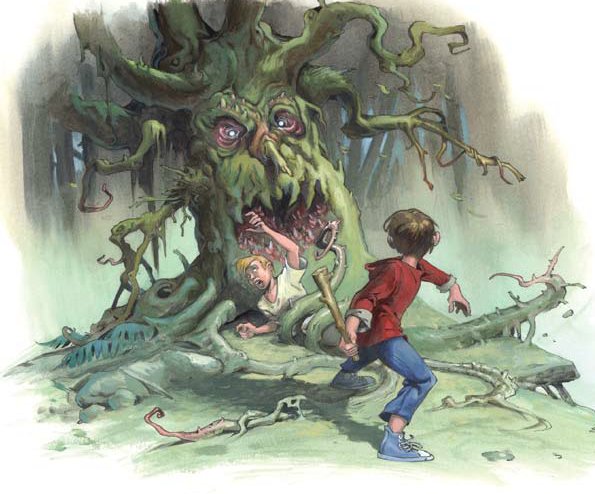
The Castle of the Rotten King is in the heart of the Forest. Ruled by the Rotten King (once known as Humpty Dumpty), he infects the land with his hatred. The people of Grimm fear him, as he is a ruthless and insane tyrant bent on conquering the entire Grimm Lands.
The Sea encircles the Grimm Lands, a pristine ocean with strange islands scattered across filled with colorful birds, sparkling waterfalls and dense jungles. While beautiful, it also has its ugly side. Black-hearted pirates roam the Sea, taking what they want. Madmen in great washtubs fight with each other for the right to sing. Beneath the waters are flesh-eating fish that follow the currents. Sharks prowl the depths. Most people view the Sea as a final barrier and only those with incredible courage or lack of intelligence would go beyond the sight of land. It's rumored that the Sea goes on and on until it reaches the end of the world, spilling out into nothingness.
The World's Edge Mountains are always on the horizon. Always. They don't want to be reached and will move if anyone starts getting close. It's said the Mountains offer the surest and quickest route to the Underworld where, if you believe talking birds, the way out of the Grimm Lands lies. However, the Underworld is yet another dangerous place as it's the home of the dead. The Mountains also hold Dragon, who lurks in his cave belching clouds of poisonous smoke. Stern dwarves make the Mountains their home and a rumored kingdom of headless people is said to be concealed within. Finally, giants live above the clouds from the mountain caps. They toss boulders back and forth, hurl lighting at the Lands below and generally make a great commotion.
The nature of Grimm is dark and gloomy, not for the faint of heart. A place of horror, corruption, and decay where wickedness reigns and the things most people are familiar with from fairy tales and nursery rhyme are completely wrong. And yet there's a place for hopes and dreams, as the PCs are beacons of light in the land. They can put the evils of the land to a rest, even if only for a short time. The cleverest and canniest kids may even make their way back home.
The Introduction ends with a segment on "What is Roleplaying" where they explain how it works, and the role the GM (called Narrator in this system) has. For dice you just need a couple d6s, usually one for each player.
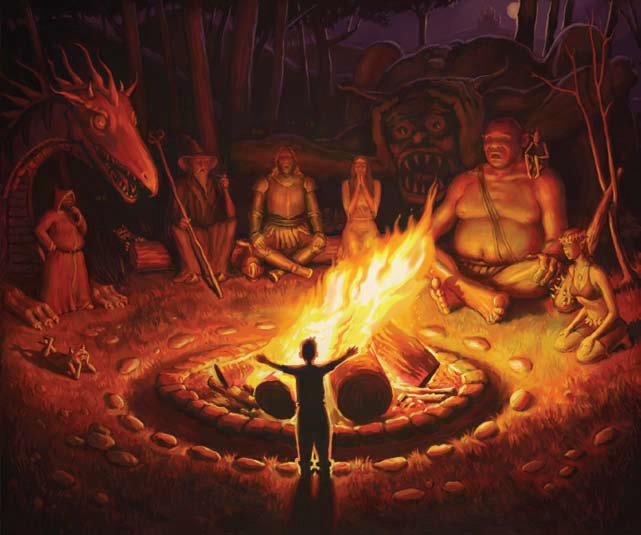
Next up: Being a Kid - the basics of making a PC and how character advancement works.
Being a Kid
Original SA post Grimm – Being a KidThis chapter introduces the player to the system (somewhat), and gives five steps to go through for making your character. In Grimm, abilities are rated in grades ranging from no skill at all (or kindergarten) to 12th grade. Difficulties are also rated in grades (a lock may be 3rd grade to open) as well as results (so after rolling you might say you got a result of 4th grade). You also have a personal grade level, which is basically your level and determines how many wounds you can take. Characters start at 3rd grade. A handy sidebar gives typical ages for grades for players who aren’t from the U.S. and might not know what they mean.
Step one is physical features. This is fairly simple to go through since as a human child these are pretty much decided for you. The game assumes the characters will be between 9 and 12 years of age, the age at which their sense of wonder and imagination makes them vulnerable to the hidden entrances of Grimm. A few suggestions for why this age range and no younger are given. Perhaps younger children have the sense to stay away. Or maybe the Lands prefer children who are more “seasoned”, having experienced more of life that the denizens can rip away like a steak that’s been marinated.
Shape and stature are discussed next. Shape is a general description of what a creature looks like and can do. Kids (and other humans) are person-shaped. Stature is size, with the following categories: mouse-sized, cat-sized, dog-sized, kid-sized, adult-sized, moose-sized, elephant-size, whale-size, and dinosaur-size. Anything smaller then a mouse is probably nothing to worry about, and something bigger then a dinosaur is just plain big. Stature is based on the characters so if they change size (by drinking a potion that shrinks them for example) then the narrator adjusts the stature of other creatures accordingly. Chapter Four covers the mechanical aspects of size.
Speed is the final part of this step. Speed categories are really slow, slow, average, fast, and really fast. Kids have average speed. Like stature, speed is given a little more detail in Chapter Four.
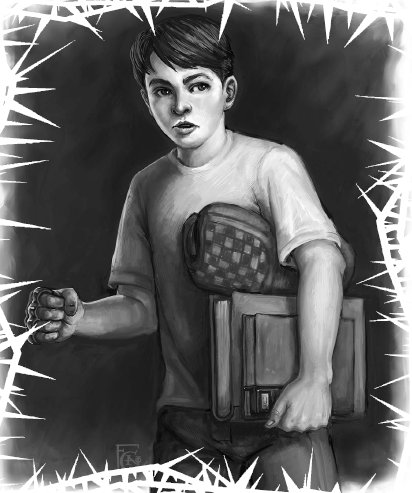
I really like the idea of a kid punching fairy tale monsters with a set of brass knuckles
Step two is picking your archetype, which give you certain abilities and determine what level various traits start at. While the kids who get pulled in may not have too much in common, they share one thing – they all seem to fit into stereotypes. This may be because the Grimm Lands are compromised of well-known stories and populated with iconic figures so it attracts iconic victims. Maybe children brought through are streamlined and made into somewhat of a caricature, or the kids take unconsciously take on the roles to remind themselves where they came from.
Archetypes help the narrator and other players figure out what kind of character you’ll be playing. While not all characters of the same archetype have to be completely the same, they help act as a general template and jumping-off point for your character. They tell you and the rest of the group what your character will be good at and what will be problematic for them. You can’t ever change your archetype, so be sure to pick one you’ll like.
The archetypes in Grimm are: Bully, Dreamer, Jock, Nerd, Normal Kid, Outcast, and Popular Kid.
Step three is traits and talents. Traits are the basic building block of characters – such as physical abilities, social skills, knowledge, and things like your level of creativity and how lucky you are. Talents are special tricks your character can do that set you apart from other character, even those of the same archetype. The two types of talents are archetype talents (provided by your archetype) and general talents (which anyone can take if they qualify for it).
The book proceeds to give an example of a player creating a Bully character and altering her traits around, but the problem is they don’t tell you what the traits of the game are or what they mean yet. They also don’t tell you what personal grade characters start at - I actually thought it was 1st until looking later in the book and finding it was 3rd. They don’t even tell you how you roll to do stuff yet! I think it’s assumed you’ll look through the Archetype chapter and then the Traits and Talents chapter, but I feel it would have been better to at least describe traits and how the system works first. For the purposes of this review I’ll list the categories and their names. You can probably guess what they cover from it, and I’ll go into more detail once we hit that chapter.
Core traits: Cool, Pluck, Imagination, Luck, Muscle
Playground traits: Hide, Seek, Scamper, Scrap, Throw
Study traits: 4-H, Book Learning, Boy Scouts, Country Club, Gaming, Home Ec, Industrial Arts
When making your character, you have 8 credits to spend. Increasing a Core trait by one costs 3, increasing a Playground trait by one costs 2, and increasing a Study trait by one costs 1. You can lower a trait by 1 and increase another in the same category by one, but don’t specialize too much or you won’t be able to do much when that trait can’t help. You cannot have a trait higher then 6th grade at character creation.
You then pick a Core trait to be iconic. This lets you accomplish amazing things at the expense of lowering that stat by one or more levels for the rest of the adventure.
Each character gets a general talent, and may choose an origin talent as well if they wish. Origin talents give you a bonus at certain things but also inflict a penalty in other circumstances.
Step four is basically thinking of who your character is and what they look like. What is their name, where did they come from, how do they feel about being pulled into the Grimm Lands, what do they wear, do they know the other PCs, etc.
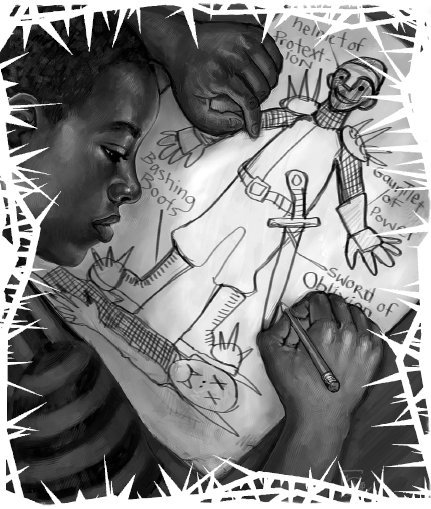
Step five is coming up with how your character got into the Grimm Lands, if it’s not determined by the narrator. You also list what items your character had on them when they came over. Whether the kids gear turns into medieval appropriate items or stays as is to make them stand out even more is the narrator’s decision. You choose one of your character’s items that will become a keepsake, which means it will take on magical properties. You might not have a choice as to what those powers are, but they’ll be thematically related to the item. A later chapter gives several examples.
The end of the chapter covers advancement. At the end of every story (an adventure), your character graduates. This increases their personal grade by one, which lets them take an additional wound. They also gain eight credits which can be spent to boost traits just like in character creation. When advancing to an even-numbered grade a character gains an archetype talent of their choice. Odd-numbers grades grant a general talent.
Next – Character Archetypes
Classes: The Bully
Original SA post Grimm - Character Archetypes: The BullyNow we’re getting into what you can do. Each Archetype lists starting trait levels, a specialty, a weakness, and a starting archetype talent; along with a list of more you can take as you level up. A grade level listed next to an archetype talent means the character must be at least that personal grade level to take it. Any traits not listed are at Kindergarten level. I’ll be going through the archetypes one at a time.
Specialties are a bonus to rolling the “initial roll” of a certain trait. When we hit the chapter that actually tells us how to roll things in the game you’ll see how exactly it works. For now, it’s basically a bonus dice you roll and take the better result of the two.
Some of the abilities refer to mechanics that haven’t been explained yet. I’ll give a brief description of what they mean when they show up.
Let’s look at the Bully.
The Bully
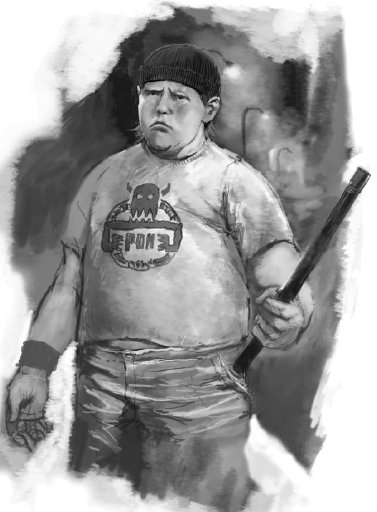
Formerly used to terrorizing the playgrounds and ruling the roost at school, the Bully has now been dropped into a situation where they need the help of others to survive. Bullies are strong and resilient, making them good characters to go up and Scrap with attacking monsters of their own size. However, they’re at a disadvantage when the foe is bigger then them, and tend not to have many other abilities then being strong and intimidating.
Core traits : Cool 2nd, Pluck 1st, Imagination 1st, Luck 1st, Muscle 4th
Playground traits : Hide 1st, Seek 2nd, Scamper 1st, Scrap 4th, Throw 2nd
Study traits : Industrial Arts 3rd, Juvie 2nd
Specialty : Bullies are well-practiced in the art of brawling. They get to roll an additional dice on the initial roll of Scrap tests.
Flaw : A Bully is only comfortable as long as he has the upper hand. Each time the Bully suffers a wound, he must make a Pluck test with a difficulty equal to his total number of wounds (including the just-suffered one). If he fails, he becomes scared (meaning he can’t do anything productive), and continues to be scared until either the wound is healed or the source of his injury is neutralized or no longer present.
Threats : The Bully is good at pushing around those who are smaller or weaker then him. He may spend a turn making an opposed Cool test to someone within a stone’s throw (one of the measurements of range, somewhere between 20 to 50 feet) who can see or hear him. The target doesn’t have to understand the Bully’s language so long as they are intelligent enough to read his body language or tone of voice. The target must fulfill at least one of three requirements:
1) Has a lower personal grade level then the Bully
2) Has a lower Muscle trait then the Bully
3) Is of a smaller stature then the Bully
If the Bully wins, he gets an advantage to all Scrap tests against the target for the rest of the scene. This bonus is equal to +1 for each grade by which he wins the test.
Archetype Talents
Gang Up : Characters normally receive +1 dice per person when others team up to help them with Scrap tests. A Bully is used to having toadies back them up, so a Bully with this talent gains +2 dice per person helping in a Scrap test.
Intimidating : Bullies may have some social skills (mainly to get out of trouble), but their skills are most impressive when they use violence or the threat of violence to persuade or manipulate others. In these situations the Bully gains a +2 bonus to Cool tests. This does apply to the Bully’s Threats ability.
Pile-on : Headlocks and wedgies are often a part of a Bully’s repertoire. When wrestling with foes that are his stature size or smaller, the Bully is considered to be one stature size larger for the purposes of determining his and his opponent’s penalties and movement limitations.
Protector : Some Bullies, once forced to trust and rely on their peers, realize their true purpose isn’t to terrorize those who are smaller then them but to protect them instead. When an adjacent ally is the target of an attack, a Bully may interpose himself and take the attack instead. He must declare this before the attack is rolled, but the attack is rolled against the Bully instead of the original target.
Threats, Advanced : Only a Bully with the Threats ability can take this. He must declare he is using the Advanced version before he rolls and only succeeds at causing any result if he beats the opponent by three or more grades. Alternatively, upon causing a Threats result he may expend one grade of Imagination to boost the result. If the Bully succeeds at making an Advanced Threats result, in addition to the Bully getting the bonus the target refuses to attack the Bully in melee.
Threats, Master (8th grade or higher) : Only a Bully with the Advanced Threats ability can take this. He must declare he is using the Master version before he rolls and only succeeds at causing any result if he wins the opposed contest by six or more grades. Alternatively, upon causing an Advanced Threats result he may expend two grades of Imagination to boost the result. If the Bully succeeds at making a Master Threats result, in addition to getting the bonus and the target refusing to attack him in melee, the target is terrified of the Bully and does his best to flee from him each turn.
Classes: The Dreamer
Original SA post Grimm – Character Archetypes: The Dreamer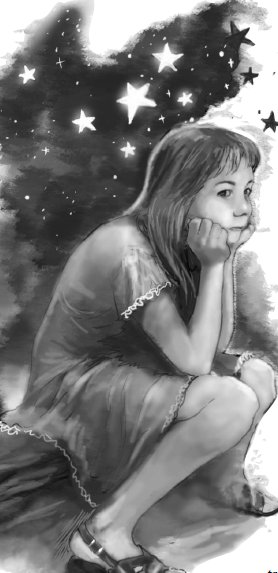
Dreamers are the kids who often daydream, lost in their own imaginary worlds. They preferred to read about dragons, knights, and other heroic things instead of paying attention in class. Now that they’re in a world shaped by imagination and populated with fantastic creatures, that time spent comes in handy. While everyone else is getting used to how things work and any new powers, the Dreamer has a natural control over her imagination. In a small group they may even become the leader as they truly understand the world of Grimm
Core traits : Cool 1st, Pluck 1st, Imagination 4th, Luck 2nd, Muscle 1st
Playground traits : Hide 2nd, Seek 4th, Scamper 2nd, Scrap 1st, Throw 2nd
Study traits : 4-H 1st, Book Learning 2nd, Boy Scouts 1st, Gaming 3rd, Home Ec 1st
Specialty : A Dreamer has great talent to understand, embrace, and even manipulate the Grimm Lands. They always roll an extra dice on the initial roll of Imagination tests.
Flaw : Dreamers tend to lose themselves in their thoughts and imaginings – as well as nightmares. Dreamers are therefore more susceptible to illusions, charm spells, and other things that toy with the mind. They take a -1 penalty to all tests to resist such abilities.
I Think I Can : By believing in herself the Dreamer can accomplish almost anything. Dreamers may choose two iconic Core traits, one of which is Imagination. Alternatively she can have Imagination as her only iconic trait which means each level of Imagination she expends for special results counts as two.
Archetype Talents
Bonus Keepsake : The Dreamer’s Imagination imbues another item with power, manifesting as a keepsake designed by the Dreamer’s player and narrator.
Happy Thoughts : To a Dreamer anything can be fixed with the power of belief, even dire wounds. When a Dreamer expends Imagination to heal her own wounds, she heals two wounds per Imagination spent. When healing others, she heals one wound per Imagination spent.
Observant : Dreamers are so in touch with the Grimm Lands that they have an almost superhuman awareness of their surroundings. They may expend 1 Imagination to ignore environmental or conditional penalties to visibility, hearing, etc. for the rest of the scene. Examples of using this ability are being able to spot a monster hiding in darkness, or hearing a whisper in the midst of a cacophony.
Rapid Recovery : Dreamers may recover Imagination far more quickly. Once per story, when the Dreamer spends half an hour doing nothing but idle daydreaming, she may recover half of her expended Imagination (rounded down).
Spontaneous Spellslinger : While most kids have to be taught magic to use it right, the Dreamer has an inherent ability to manipulate arcane energies through harnessing them with the power of her Imagination. By expending Imagination equal to the magic spell’s circle level, she may spontaneously recreate the effect of any spell she’s witnessed cast during the current story. She does not suffer estrangement or weakness (two consequences of casting magic which are discussed later), but she is not considered to have learnt the spell either.
True Hero (8th grade or higher) : When the need is great and a true hero is called for, the Dreamer can become the hero she’s imagined herself to be. By spending one turn and expending half of her maximum Imagination (rounded up), she may transform into a shining figure of power and grace, such as a knight or great hunter or angel. The effects last for one scene and can only be called upon during an appropriately dramatic moment, as decided by the narrator. The Dreamer gains a special ability appropriate to her avatar: an angel may be able to fly, a hunter may be able to track and fire her bow in any terrain or weather, and a knight may be able to strike true (ignoring all protection) against a foe who has no honor in his heart. She also gains the following abilities:
1) Increase stature by one level
2) Increase speed by one level
3) Add +2 grades to any of the following three: Muscle, Pluck, Scamper, Scrap, Seek, Throw
Classes: The Jock
Original SA post Grimm - Character Archetypes: The Jock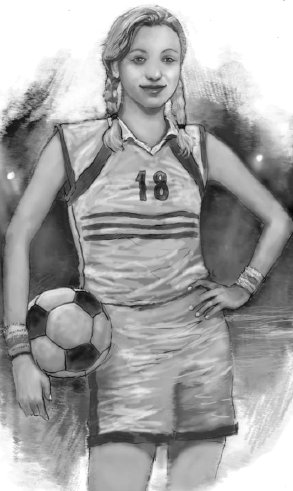
The Jock is a sports player used to working together with others and at an age where their teams were more likely co-ed rather then spilt into gender-based team. Now that they’re in the Grimm Lands that experience serves them well. They get along with everyone, understand the value of working together, and refuse to give up. While not as strong as Bullies, Jocks have a bit more physical diversity. The downside is that Jocks never really had much time for academics, reading, or flights of fancy so while other kids may be somewhat familiar with the terrors of the Grimm Lands, Jocks are often clueless. Although in some cases, ignorance may be bliss.
Core traits : Cool 2nd, Pluck 2nd, Imagination 1st, Luck 1st, Muscle 3rd
Playground traits : Hide 1st, Seek 1st, Scamper 4th, Scrap 2nd, Throw 4th
Study traits : Book Learning 1st
Specialty : Jocks may choose a specialty from among Scamper, Muscle, or Throw depending on which sport they played while in the real world. Whatever trait the Jock chooses, he always rolls an extra dice on the initial rolls.
Flaw : Jocks pursue physical prowess at the expense of intellectual and social activities. A Jock may only focus on or step up on (basically taking time to get a bonus) or receive teamwork bonus dice on Scamper, Muscle, and Throw tests. If the Jock’s iconic Core trait is Luck, he may only expend it on those tests as well.
The Winning Play : By calling on some hidden reserve, the Jock can push himself past his normal limits. Once per scene without taking an action, the Jock may gain +1 grade to Scamper, Throw, and Muscle tests for the rest of the scene. Afterwards, the Jock’s Muscle trait is expended by one grade.
Archetype Talents
Bonus Talent : The Jock may select any talent that has either a Playground trait or Muscle as a requirement. He must still meet all of the other talent’s requirements. This may be taken multiple times.
Competitive : Some Jocks thrive on spectators and proving they’re the best at what they do. When performing opposed tests while in a contest, particularly while in front of a group of watchers who are doing nothing but watching the contest between the Jock and other character, the Jock receives +2 grades to all Playground traits and on Muscle tests. This advantage can’t be applied in combat unless the Jock is in gladiatorial combat or something like it.
Fearless : Jocks are tough, focused, and not very smart. They’re either too brave or too dumb to be worried about the danger a monster represents, or maybe they’re just simply incredibly confident in their abilities. Once an action scene starts (including during an ambush round), the Jock receives +2 to all Pluck tests.
Sports Specialization : When using equipment appropriate to one of the Jock’s favored sports, he gains a special benefit. If it could be used as a weapon (like a baseball bat), he deals +1 damage. If it could be used as armor, like a helmet, shoulder pads, or shin guards then he gains protection 1 (reduces damage by one). If the equipment is something else then the narrator may come up with a physical benefit that fits. For example, running shoes might increase the Jock’s speed by one level.
Team Spirit : Being a team player, the Jock benefits when working with others. His friendly intentions also encourage others to do their best. Even when he spends his turn doing something other then providing teamwork, he may grant a bonus teamwork die to anyone within a cricket’s hop (a short distance, between just out of reach and 20 feet) so long as that character is spending his turn doing the same thing as the Jock.
Winner’s Mindset (8th grade or higher) : Successful Jocks not only perform on a physical level, they also constantly apply their minds to the situation at hand. They can mentally run through tasks in their head, psyche themselves up, etc. A Jock may focus on a Playground trait in additional to whatever action he’s taken this turn. (This makes it more likely he’ll get a higher result). He can focus on different traits as he wishes, going back and forth, but once he makes a test on a trait he’s been focusing on the benefit is spent.
Classes: The Nerd
Original SA post Grimm – Archetypes: The Nerd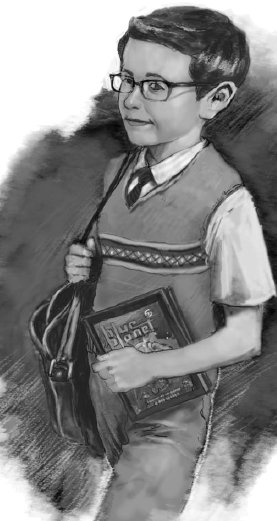
Some called the Nerd a prodigy, others a geek. Some don’t even acknowledge his existence. He may not have much of a social life or do much outdoors activities, but the Nerd knows a lot, as he actually studies. Now in the Grimm Lands, he has the advantage of being armed with knowledge that can help the group navigate through the Lands. They overlap a bit with the Dreamer in knowledge of the fantastic, but bolster it with advanced abilities in Classroom traits.
Core traits : Cool 1st, Pluck 2nd, Imagination 2nd, Luck 1st, Muscle 1st
Playground traits : Hide 3rd, Seek 4th, Scamper 1st, Scrap 1st, Throw 1st
Study traits : 4-H 1st, Book Learning 4th, Boy Scouts 1st, Gaming 4th
Specialty : Nerds have great memories and love learning. They roll an extra dice on the Initial roll of all Study traits.
Flaw : Nerds are scrawny, weak, socially-awkward kids. Nerds may never focus on, step up on, or receive teamwork bonus dice on Cool, Muscle, or Scrap tests. If a Nerd’s iconic Core trait is Luck, he cannot expend it on those tests.
Studious : Did I mention Nerds love to study? At character creation and each time they increase a personal grade level, two of a Nerd’s Study traits increase by one for free.
Archetype Talents
Astounding Intellect : The Grimm Lands are full of bizarre devices, enchanted items, and weird puzzles, all of which a Nerd is good at understanding. Nerds gain a +2 advantage to Imagination tests to solve puzzles or any other tests involving riddles, conundrums, or problem-solving.
Geek Celebrity : Whenever a Nerd is interacting with people who are similarly brainy, such as a king’s advisor, wizards, or a sphinx, he may use his Book Learning in place of Cool for the purposes of making a good impression. In addition, by expending 1 Imagination and succeeding on an opposed Book Learning test, the Nerd may cause such listeners to become fascinated, as per the enchanter spell.
Insight : Sometimes inspiration comes like a bolt of lightning just when needed. By spending a turn and expending 1 Imagination the Nerd may ask the narrator a question they must answer. The knowledge gained can be just about anything, from a villain’s true motivation to his most likely plan of attack against the kids, from a creature’s weakness to its most dangerous ability, from a detail of a previous adventure to an advanced scientific theory the child would not normally comprehend. The answer should be helpful, but may take the form of a hint or cryptic reply.
Quick Study : The Nerd understands lessons easily. He can learn a magic spell from apprenticeship or study in half the time.
Skeptic : The enchanting magic of the Grimm Lands neither bothers or frightens the Nerd anymore and he has honed his emotions to a Vulcan-like void. The Nerd gains +2 grades on any tests against temptation, despair, and effects that would affect his emotions.
That’s Illogical! (8th grade or higher) : If a Nerd believes in anything, it’s logic. By expending half of his imagination (rounded up), the Nerd can force a target creature within a stone’s throw to attempt a Pluck test versus the Nerd’s Book Learning. If the creature fails, it loses access to any abilities that can’t be explained by modern science (such as magical spells or supernatural powers). This effect lasts as long as the Nerd continues to spend his turn explaining to everyone present (even if they’re not listening to him) why those abilities just can’t work.
Classes: The Normal Kid
Original SA post Grimm – Character Archetypes: The Normal Kid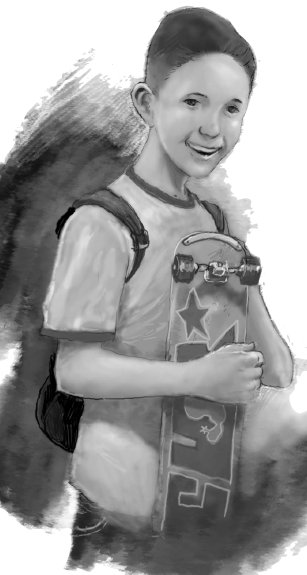
The Normal Kid is, well, a fairly normal kid. Nothing too exceptional about him, but nothing bad either. The Normal Kid may be a blank slate, someone who doesn’t really fit into one of the other archetypes. In this case the Normal Kid is whatever the player makes of him with strengths and weakness that seem appropriate. However, they’ll never be as good as the other archetype at their abilities. Alternatively a Normal Kid could be so average, so well-rounded, and so kid-ish that everything they do is generic. This can be good for the rest of the group as the Normal Kid can fill any role in a pinch. It might not be much fun for the Normal Kid though.
Core traits : Cool 2nd, Pluck 2nd, Imagination 2nd, Luck 2nd, Muscle 2nd
Playground traits : Hide 2nd, Seek 2nd, Scamper 2nd, Scrap 2nd, Throw 2nd
Study traits : Book Learning 2nd
Specialty : A Normal Kid may choose any one trait as his specialty. When making a test in this trait, he rolls an extra dice for the initial roll.
Flaw : Normal Kids are generic. This has two effects. First, the Normal Kid cannot have a trait that exceeds another trait of its type by more then one as they rarely specialize in any particular area. For instance, if a Normal Kid has Muscle at 3rd grade and his other Core traits were 2nd, he must advance the other Core traits to 3rd level before being allowed to advance Muscle to 4th.
Second, Normal Kids are a dime a dozen, the people who bad things happen to that show how dangerous the situation is. They are the red-shirts, the nameless extra, the hero’s expendable best friend. When the narrator would normally randomly determine who gets attacked, the Normal Kid is always chosen instead. Additionally, in situations where a harmful effect such as spell or area attack could just as easily include the Normal Kid as not, it will always include him even if fewer nearby kids are included.
Bonus Talent : A Normal Kid needs all the help he can get. He may select an additional talent during character creation.
Archetype Talents
Bonus Talent : The Normal Kid can select a talent for which he qualifies. This may be taken multiple times.
I’m Special Too! : In defiance of others perception of him, the Normal Kid can be special – or at least his traits can be. The Normal Kid can expend a single grade in a Core trait other then his iconic Core trait with the usual benefits. He can only do this once per trait per story.
Social Chameleon : Normal Kids tend to blend in with the crowd. In the Grimm Lands, their predisposition to this kind of behavior has an unusual result. Once per scene, the Normal Kid temporarily gains the beginning archetype talent of any other archetype. For instance, he may emulate the Bully’s Threats ability, the Jock’s Winning Play ability, or even gain a temporary increase to his Study traits (two +1 increases per personal grade above 3rd divided evenly among all of his Study traits) in emulation of the Nerd’s Studious ability.
Survivor : Normal Kids tend to be pretty resilient. A Normal Kid’s health is one higher then his personal grade.
Understudy : Some Normal Kids are always wishing they could be in the spotlight. Others don’t care but spent so little time specializing in one thing that they pick up and learn what others are doing. Anytime one of the Normal Kid’s fellow children is knocked out, the Normal kid can choose one of that kid’s traits, talents, archetype abilities, or known spells. Until that other kid wakes up, the Normal Kid can use that aspect in his stead.
Unusual Heritage (8th grade or higher) : Not all Normal Kids remain normal forever. Some find they have a strange and fantastic heritage. The exact effects are determined by the narrator and each should be unique. Several examples are given:
Descended from Kings : As a child you wandered away from your true home and into the mundane world. Now, after many adventures and strange clues you have learned the truth of who you are. You are accepted back into the arms of your royal parents and become the heir to one of the Checkerboard Kingdoms. This means you now have access to troops, wealth, and a safe haven. But you also have new responsibilities, potentially restrictive parents, and the attention of anyone who wishes to harm or conquer your kingdom (such as the Rotten King).
Fairy Kin : You are actually a changeling, left in the place of a baby from the mundane world. Now that you’ve come to a place closer to the fey lands your latent powers have awoken. You may be recognized by all other fairies and given special treatment and subtle aid through your journey. Or a more profound change can occur - You go into a chrysalis one night and emerge as a cat-sized elfin kid with butterfly or dragon-fly wings, giving you a speed of fast when flying. You also instantly learn three 1st-circle spells from the artisan, enchanter, and guardian spell lists. You can use magical powers without suffering from weakness or estrangement. However, by becoming a fairy you have forsaken the Real World and may never leave the Grimm Lands.
Moonstruck : You’ve had weird and disturbing dreams of hunting down prey and killing it with your teeth, and now you know why: You are a wolf in kid’s clothing, banished by the Big Bad Wolf for challenging his domain. Half of the dogs, wolves, and other canines will roll over for you accepting your dominance. The other half maintains their allegiance to the Big Bad Wolf and are automatically hostile towards you. The narrator determines which side a canine takes by either rolling randomly or deciding based on the story needs. You manifest your heritage now, becoming obsessed with the moon and evening barking at those who alarm you. You also gain a dog’s Sniffer ability, which grants +4 grades on Seek or Boy Scout tests to track by smell. Every morning you decide if you’re going to be a wolf or human today. If you choose to be a wolf you gain all the physical features of a wolf (teeth, protective hide, speed, and scent). You can’t speak any human language while a wolf, but whether in human or wolf form you can always speak to canines.